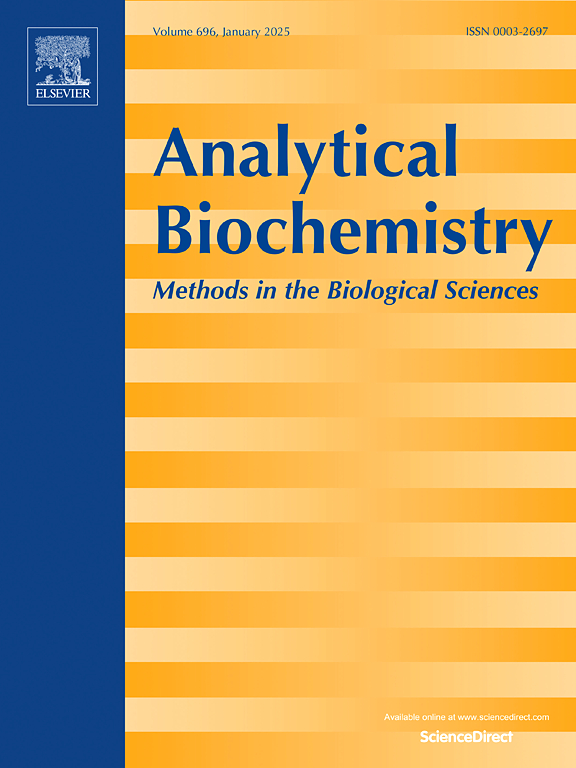Dual-screen-printed electrode platform for simultaneous detection of IgG and IgM antibodies using magnetic beads nanocomplexes
IF 2.5
4区 生物学
Q2 BIOCHEMICAL RESEARCH METHODS
引用次数: 0
Abstract
This study uses a dual-screen-printed electrode platform to investigate the electrochemical behavior of magnetic platforms with varying sizes for sensitive detection of immunoglobulin G (IgG) and immunoglobulin M (IgM) antibodies. Magnetic beads of 500 nm and 1 μm in diameter were functionalized with amino ferrocene and the receptor-binding domain of the severe acute SARS-CoV-2 spike protein. The sensor utilized a dual screen-printed electrode (SPE) system with spatially separated working electrodes, each immobilized with either anti-IgG or anti-IgM capture antibodies. A bipotentiostat was employed to independently monitor the electrochemical signals from these two working electrodes. Following incubation with target antibodies within a concentration range of 0.1 μg/mL to 200 μg/mL, the magnetic bead complexes were captured on their respective electrodes, and simultaneous electrochemical measurements of both IgG and IgM were conducted. The sensor's performance was evaluated in both buffer solutions and a complex serum-like matrix. Results showed distinct and quantifiable electrochemical responses for IgG and IgM, with minimal interference between the analytes. While matrix effects were observed, the sensor demonstrated its potential for simultaneous detection of SARS-CoV-2 antibodies in complex biological samples.

利用磁珠纳米复合物同时检测IgG和IgM抗体的双丝网印刷电极平台
本研究采用双丝网印刷电极平台,研究了不同尺寸磁性平台对免疫球蛋白G (IgG)和免疫球蛋白M (IgM)抗体的电化学行为。用氨基二茂铁和SARS-CoV-2严重急性刺突蛋白受体结合域功能化了直径为500 nm、直径为1 μm的磁珠。该传感器采用双丝网印刷电极(SPE)系统,具有空间分离的工作电极,每个电极都固定有抗igg或抗igm捕获抗体。采用双恒电位器分别监测两个工作电极的电化学信号。与浓度在0.1 μg/mL ~ 200 μg/mL范围内的靶抗体孵育后,在各自的电极上捕获磁珠复合物,同时对IgG和IgM进行电化学测量。在缓冲溶液和复杂的血清样基质中对传感器的性能进行了评估。结果显示,IgG和IgM的电化学反应明显且可量化,分析物之间的干扰最小。虽然观察到基质效应,但该传感器证明了其在复杂生物样品中同时检测SARS-CoV-2抗体的潜力。
本文章由计算机程序翻译,如有差异,请以英文原文为准。
求助全文
约1分钟内获得全文
求助全文
来源期刊

Analytical biochemistry
生物-分析化学
CiteScore
5.70
自引率
0.00%
发文量
283
审稿时长
44 days
期刊介绍:
The journal''s title Analytical Biochemistry: Methods in the Biological Sciences declares its broad scope: methods for the basic biological sciences that include biochemistry, molecular genetics, cell biology, proteomics, immunology, bioinformatics and wherever the frontiers of research take the field.
The emphasis is on methods from the strictly analytical to the more preparative that would include novel approaches to protein purification as well as improvements in cell and organ culture. The actual techniques are equally inclusive ranging from aptamers to zymology.
The journal has been particularly active in:
-Analytical techniques for biological molecules-
Aptamer selection and utilization-
Biosensors-
Chromatography-
Cloning, sequencing and mutagenesis-
Electrochemical methods-
Electrophoresis-
Enzyme characterization methods-
Immunological approaches-
Mass spectrometry of proteins and nucleic acids-
Metabolomics-
Nano level techniques-
Optical spectroscopy in all its forms.
The journal is reluctant to include most drug and strictly clinical studies as there are more suitable publication platforms for these types of papers.
 求助内容:
求助内容: 应助结果提醒方式:
应助结果提醒方式:


